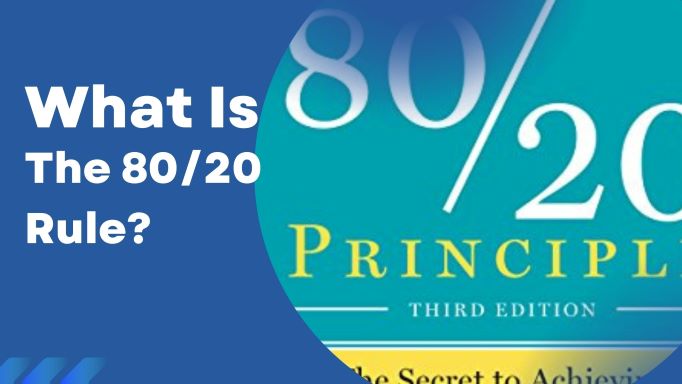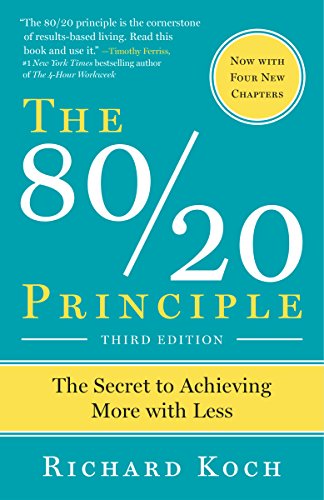What Is The 80/20 Rule? Have ever heard of it? You’re not alone if you’ve ever felt like you’re trying to accomplish everything at once or spreading yourself too thin in your professional and personal lives. You can’t pay attention to everything all the time. And you shouldn’t be trying, according to this week’s book.
Have you heard of Vilfredo Pareto, the economist? He observed something unusual regarding distribution. He notes that distribution is not even, it is heavily skewed.
It adheres to an 80/20 model. It’s referred to as Pareto’s Principle or the 80/20 Principle. In his book, The 80/20 Idea: The Secret to Achieving More with Less, Richard Koch goes into great depth on this 1896 principle. It is a concept worth learning.
What Is The 80/20 Rule?: The 80/20 Principle — The Secret to Achieving More With Less
What Is The 80/20 Principle? – Understanding The 80/20 Rule
The basic idea is straightforward. Eighty percent of the time, twenty percent of the work yields eighty percent of the outcomes. For example, 20% of the goods account for 80% of revenue. Eighty percent of the traffic is carried by twenty percent of the roadways. This also indicates that 80 percent of the work produces just 20 percent of the outcomes. According to Koch, we can do more to optimize the positive 20% of effort while minimizing the bad 80%.
The goal here is to demonstrate how the world is essentially imbalanced. The idea was first identified by the Italian economist Pareto (and is sometimes known as Pareto’s Law), and it has been the basis of strategic management consultants and the secret of more successful firms.
Because it violates traditional economic theory, its effects may seem magical to people who are unaware of it. Not coincidentally, it’s also known as the “rule of least effort.”
However, the principle is an observation of reality rather than a hypothesis. Unlike many of the self-help classics’ spiritual or philosophical precepts, the 80/20 principle, according to Koch, works whether you believe in it or not.
Why It Is Important Now
As humans, we make assumptions, one of which is that all causes are of equal importance, more or less. We believe that every piece of business, every product, and every lead is as important as the next. While this is a fairly democratic outlook on life, Koch refers to it as the “50/50 fallacy.” He contends that almost everything in life, at least in terms of work and reward, is intrinsically unbalanced – it may not always be 80/20 (though it often is), but things aren’t as balanced as we believe – and we’re frequently startled by the depth of the imbalance.
But this isn’t a cause to be disheartened — it’s a chance, both in business and in life. Koch thinks that by using and embracing the 80/20 principle, companies can become more lucrative, governments can become more effective, and we can all become happier and more successful. It’s not only about getting rid of the 80 percent that doesn’t work; it’s also about doing more of the 20% that works.
The 50:50 Rule vs. The 80/20 Rule
In terms of work put in vs outcomes obtained, a 50:50 ratio makes sense. For decades, this mindset has guided civilization. A clear work/reward relationship creates a stable society in which mediocrity is tolerated and conformity is rewarded. Unfortunately, as Koch shows, this is no longer the reality we live in.
The new world declares that ‘keeping up’ will no longer suffice, and that competence will no longer be rewarded with success. You must pursue something that comes naturally to you and that you like to have a significant edge over others and advance to the top of your profession.
In the 80/20 universe, people who follow its principles may anticipate tenfold more returns than they put in. However, that input must be of particularly high quality and represent the giver’s distinctiveness.
According to the 80/20 principle, Michael Jordan should be paid more than a half-dozen basketball teams combined because of his superior abilities and entertainment value.
Becoming a Time Revolutionary
The majority of what we deem value is derived from a small portion of how we spend our time. To boost our effectiveness, enjoyment, or earnings, we must raise that fraction beyond 10% or 20% to a far larger part of our time. According to Koch, our culture has low regard for time. ‘We don’t need time management,’ he claims. ‘We need a time revolution.’
Traditional time management is concerned with boosting the efficiency of our work and improving our prioritization skills. The assumption that we know what is and is not a good use of our time, according to Koch, is the weakness of all sorts of time management rules. Its second flaw is that it assumes time is limited. ‘Most people strive too hard at the wrong things,’ says Koch.
Trying to enhance our time management by 15% to 25% (as time management organizers advertise) is ‘tinkering around the fringes,’ according to Koch. Time is abundant; once we begin to spend it on the 20% that counts. Instead of constantly being short on time, the frightening fact is that we are drenched with it yet “profligate in its misuse.”
Overview of the 80/20 Principle
Koch devoted 319 pages to the subject. He divided the 20 chapters into five sections:
- Overture
- Corporate success does not have to be a mystery.
- Work less, earn more, and have more fun.
- The 80/20 scenario
- The idea was revisited
The first portion of The 80/20 Principle explained the 80/20 principle as well as the research background that led up to it. Other researchers, such as Zipf and Juran, discovered that certain attempts resulted in an uneven outcome.
As the world is unbalanced; learning to recognize and exploit the imbalance results in benefits. Koch offered several instances of the 80/20 principle in action throughout the book.
One of the most essential parts of the book demonstrated how to calculate and visualize the 80/20 model for almost any topic. Koch demonstrated how it is done for beer consumers.
Koch stressed that it was not as simple as eliminating the 80 percent that was not producing favorable outcomes. To truly understand what is going on, one needs to examine the complete catalog. The 80/20 rule is merely a technique to aid in the analysis.
In the book, he presented several case studies to demonstrate how the 80/20 principle may be applied to discover areas for improvement and deemphasis. Koch also suggested tactics for achieving the best outcomes.
The 80/20 approach is based on simplifying. The more complicated your program, the more waste you will generate. The more you simplify, the better the results will be.
Koch also presented five business examples of how the 80/20 rule might be used. Strategy, quality, service improvement, marketing, selling, information technology, decision making, inventory management, project management, and negotiating were some of the examples.
One of the most important pieces of advice was to “move 20% of people (including yourself) away from 80% activities and toward 20% activities” (Koch, 2017, p. 133).
The 80/20 rule does not only apply to work. It can also be used to make the most of your leisure time. We get 80% of our enjoyment from 20% of our time, hobbies, or relationships. The question is how we can increase our share of the 20%. 20% of the people you hang out with cause you to have 80% of the headaches, whereas 20% of the people you hang out with cause you to have the most fun. Choose wisely.
One of the most fascinating debates centered on the idea of time. Koch suggested that we do not conventionally manage our time. Instead, we should devote 20% of our time to activities that provide greater beneficial consequences.
He also adapted this style of thinking to the people you hang out with as well as your relationship with money. These are certain concepts that I need to investigate more.
Final Thoughts
The 80/20 Principle is a how-to guide for breaking out from the rat race and living up to one’s full potential. It demonstrates how trivia clogs up our lives and how complaints of ‘busyness’ can conceal a lack of purpose. These are common themes in self-help literature, but Koch’s application of one of the universe’s “power laws” lends these ideas extra weight. Who could dismiss an action logic based on “working with the universe rather than against it”?
The book is especially useful for grasping the alchemy of success in today’s economic environment, as it serves both as a business book and an interesting life guide.
I’m looking at everything through the 80/20 prism now that I’m more comfortable with it. I’m already seeing opportunities for improvement.
The 80/20 Principle was an excellent read. It is a book I will recommend to others. This book will undoubtedly assist those who run a business. Having said that, I believe that everyone can benefit from seeing the world from an 80/20 perspective.
If you would like to read my take on other books about life and business, take a look at the best trading books of all time!


